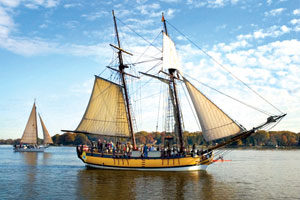December 2016 | view this story as a .pdf
Should five percent appear too small / Be thankful I don’t take it all / Cause I’m the taxman, yeah I’m the taxman. –The Beatles
By Colin W. Sargent
 Wait, what? A new trend in ship replicas educates crowds of 21st century gawkers by recreating vessels with haunting backstories. Sweet as her replica may seem today, it’s safe to say that HMS Sultana, originally designed as a yacht, was more than just annoying once the Royal Navy got hold of her and turned her into a floating tax-collector.
Wait, what? A new trend in ship replicas educates crowds of 21st century gawkers by recreating vessels with haunting backstories. Sweet as her replica may seem today, it’s safe to say that HMS Sultana, originally designed as a yacht, was more than just annoying once the Royal Navy got hold of her and turned her into a floating tax-collector.
Built in Boston and launched in 1768, Sultana was a foretopsail schooner with masts raked back “to let her sail closer to the wind.” Nimble, spiky, and bristling with armament, HMS Sultana was, from a nautical perspective, the little ship that started the Boston Tea Party.
Based in Halifax, Nova Scotia, Sultana’s duty was to collect duties. Truculently, she swept up and down the coast of the British Colonies to ports as far south as Virginia, stopping ships offshore. Usually, Sultana carried armed Redcoats to make her greeting more memorable.
In 2001, a replica of Sultana (pictured above) was created with plans traced by the legendary Smithsonian curator and sailing expert Howard I. Chapelle.
Homeported in Chestertown, Maryland, the schooner Sultana is a floating classroom directed by Drew McMullan.
“One of the reasons we selected Sultana as a candidate for reproduction was the wealth of primary information available for the vessel,” McMullan says. “When the Royal Navy purchased the original Sultana in 1768 to enforce the Townsend Acts (Tea Taxes), [it] conducted a detailed survey of the schooner, a document that is still part of the collection of the National Maritime Museum in Greenwich, England. The modern Sultana was built directly from a copy of these documents. The Royal Navy also preserved copies of both the Captain’s and Sailing Master’s logbooks, which provide two first-hand, day-to-day accounts of Sultana’s activities on the coast of Colonial North America between the fall of 1768 and the spring of 1772. The Captain of Sultana was a 25-year-old Lieutenant from Philadelphia named John Inglis, and the Master was an Englishman named David Bruce…”
So what was it like to sail with the bad guys, depending on your point of view?
“Sultana’s day-to-day operations involved stopping and searching merchant ships coming into ports along the East Coast of Colonial North America. Merchant ships were required to have an official manifest showing what items they had onboard and documenting that the proper taxes had been paid. When Sultana stopped a merchant vessel, they’d send a small boarding party over to inspect the vessel’s cargo to determine if the goods she had onboard matched the manifest. If additional, undocumented goods were found, this was an indication the vessel was engaged in smuggling, at which point Sultana’s crew would seize the vessel and sail her in company with Sultana to the closest official port of entry. Once in port, formal charges could be brought against the captain/owner of the offending vessel and a trial could be held to determine guilt.”
Tax for the memories, Sultana!
A final note. Some nautical documents reflect Sultana’s creation as a “yacht,” though others credit Cleopatra’s Barge of Salem as the first yacht in America. McMullan replies: “Sultana is referred to as a ‘yacht’ in a 1768 letter from the Royal Navy requesting her initial survey. At that time the term ‘yacht’ did not have the same meaning it does today but rather referred to a specific vessel in a merchant’s fleet that he used for personal travel. As such, a ‘yacht’ would still have been a commercial vessel but would have had slightly nicer accommodations for the owner.”





0 Comments